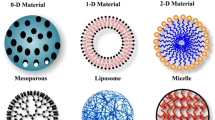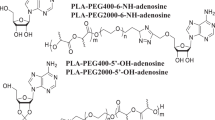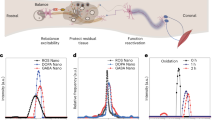Abstract
Nanoparticle-mediated drug delivery is especially useful for targets within endosomes because of the endosomal transport mechanisms of many nanomedicines within cells. Here, we report the design of a pH-responsive, soft polymeric nanoparticle for the targeting of acidified endosomes to precisely inhibit endosomal signalling events leading to chronic pain. In chronic pain, the substance P (SP) neurokinin 1 receptor (NK1R) redistributes from the plasma membrane to acidified endosomes, where it signals to maintain pain. Therefore, the NK1R in endosomes provides an important target for pain relief. The pH-responsive nanoparticles enter cells by clathrin- and dynamin-dependent endocytosis and accumulate in NK1R-containing endosomes. Following intrathecal injection into rodents, the nanoparticles, containing the FDA-approved NK1R antagonist aprepitant, inhibit SP-induced activation of spinal neurons and thus prevent pain transmission. Treatment with the nanoparticles leads to complete and persistent relief from nociceptive, inflammatory and neuropathic nociception and offers a much-needed non-opioid treatment option for chronic pain.
This is a preview of subscription content, access via your institution
Access options
Access Nature and 54 other Nature Portfolio journals
Get Nature+, our best-value online-access subscription
$29.99 / 30 days
cancel any time
Subscribe to this journal
Receive 12 print issues and online access
$259.00 per year
only $21.58 per issue
Buy this article
- Purchase on Springer Link
- Instant access to full article PDF
Prices may be subject to local taxes which are calculated during checkout






Similar content being viewed by others
Data availability
All data generated or analysed during this study are available in this Article and its Supplementary Information or from the corresponding authors upon request.
References
De Jong, W. H. & Borm, P. Drug delivery and nanoparticles: applications and hazards. Int. J. Nanomed. 3, 133–149 (2008).
Farokhzad, O. C. & Langer, R. Impact of nanotechnology on drug delivery. ACS Nano 3, 16–20 (2009).
Uhrich, K. E., Cannizzaro, S. M., Langer, R. S. & Shakesheff, K. M. Polymeric systems for controlled drug release. Chem. Rev. 99, 3181–3198 (1999).
Maeda, H. et al. Tumor vascular permeability and the EPR effect in macromolecular therapeutics: a review. J. Control Rel. 65, 271–284 (2000).
Such, G. K., Yan, Y., Johnston, A. P. R., Gunawan, S. T. & Caruso, F. Interfacing materials science and biology for drug carrier design. Adv. Mater. 27, 2278–2297 (2015).
Chan, J. M., Farokhzad, O. C. & Gao, W. pH-responsive nanoparticles for drug delivery. Mol. Pharm. 7, 1913–1920 (2010).
Lynn, D. M., Amiji, M. M. & Langer, R. pH-responsive polymer microspheres: rapid release of encapsulated material within the range of intracellular pH. Angew. Chem. Int. Ed. 40, 1707–1710 (2001).
Mura, S., Nicolas, J. & Couvreur, P. Stimuli-responsive nanocarriers for drug delivery. Nat. Mater. 12, 991–1003 (2013).
Schmaljohann, D. Thermo- and pH-responsive polymers in drug delivery. Adv. Drug Deliv. Rev. 58, 1655–1670 (2006).
Wilhelm, S. et al. Analysis of nanoparticle delivery to tumours. Nat. Rev. Mater. 1, 16014 (2016).
Zhou, K. et al. Tunable, ultrasensitive pH-responsive nanoparticles targeting specific endocytic organelles in living cells. Angew. Chem. Int. Ed. 50, 6109–6114 (2011).
Nelson, C. E. et al. Balancing cationic and hydrophobic content of PEGylated siRNA polyplexes enhances endosome escape, stability, blood circulation time and bioactivity in vivo. ACS Nano 7, 8870–8880 (2013).
Thomsen, A. R. B., Jensen, D. D., Hicks, G. A. & Bunnett, N. W. Therapeutic targeting of endosomal G protein-coupled receptors. Trends Pharmacol. Sci. 39, 879–891 (2018).
Hauser, A. S., Attwood, M. M., Rask-Andersen, M., Schiöth, H. B. & Gloriam, D. E. Trends in GPCR drug discovery: new agents, targets and indications. Nat. Rev. Drug Discov. 16, 829–842 (2017).
Murphy, J. E., Padilla, B. E., Hasdemir, B., Cottrell, G. S. & Bunnett, N. W. Endosomes: a legitimate platform for the signaling train. Proc. Natl Acad. Sci. USA 106, 17615–17622 (2009).
Vilardaga, J. P., Jean-Alphonse, F. G. & Gardella, T. J. Endosomal generation of cAMP in GPCR signaling. Nat. Chem. Biol. 10, 700–706 (2014).
Irannejad, R. et al. Functional selectivity of GPCR-directed drug action through location bias. Nat. Chem. Biol. 13, 799–806 (2017).
Stoeber, M. et al. A genetically encoded biosensor reveals location bias of opioid drug action. Neuron 98, 963–976 (2018).
Jensen, D. D. et al. Neurokinin 1 receptor signaling in endosomes mediates sustained nociception and is a viable therapeutic target for prolonged pain relief. Sci. Transl. Med. 9, eaal3447 (2017).
Jimenez-Vargas, N. N. et al. Protease-activated receptor-2 in endosomes signals persistent pain of irritable bowel syndrome. Proc. Natl Acad. Sci. USA 115, E7438–E7447 (2018).
Yarwood, R. E. et al. Endosomal signaling of the receptor for calcitonin gene-related peptide mediates pain transmission. Proc. Natl Acad. Sci. USA 114, 12309–12314 (2017).
Kramer, M. S. et al. Distinct mechanism for antidepressant activity by blockade of central substance P receptors. Science 281, 1640–1645 (1998).
Quartara, L., Altamura, M., Evangelista, S. & Maggi, C. A. Tachykinin receptor antagonists in clinical trials. Expert Opin. Investig. Drugs 18, 1843–1864 (2009).
Steinhoff, M. S., Von Mentzer, B., Geppetti, P., Pothoulakis, C. & Bunnett, N. W. Tachykinins and their receptors: contributions to physiological control and the mechanisms of disease. Physiol. Rev. 94, 265–301 (2014).
Manders, E. M. M., Verbeek, F. J. & Aten, J. A. Measurement of co-localization of objects in dual-colour confocal images. J. Microsc. 169, 375–382 (1993).
Robertson, M. J. et al. Synthesis of the PitStop family of clathrin inhibitors. Nat. Protoc. 9, 1592–1606 (2014).
Robertson, M. J., Deane, F. M., Robinson, P. J. & McCluskey, A. Synthesis of Dynole 34-2, Dynole 2-24 and Dyngo 4a for investigating dynamin GTPase. Nat. Protoc. 9, 851–870 (2014).
Mantyh, P. W. et al. Receptor endocytosis and dendrite reshaping in spinal neurons after somatosensory stimulation. Science 268, 1629–1632 (1995).
Stein, C., Millan, M. J. & Herz, A. Unilateral inflammation of the hindpaw in rats as a model of prolonged noxious stimulation: alterations in behavior and nociceptive thresholds. Pharmacol. Biochem. Behav. 31, 445–451 (1988).
Decosterd, I. & Woolf, C. J. Spared nerve injury: an animal model of persistent peripheral neuropathic pain. Pain 87, 149–158 (2000).
Bravo, D. et al. Pannexin 1: a novel participant in neuropathic pain signaling in the rat spinal cord. Pain 155, 2108–2115 (2014).
Abbadie, C., Brown, J. L., Mantyh, P. W. & Basbaum, A. I. Spinal cord substance P receptor immunoreactivity increases in both inflammatory and nerve injury models of persistent pain. Neuroscience 70, 201–209 (1996).
Geppetti, P., Veldhuis, N. A., Lieu, T. & Bunnett, N. W. G protein-coupled receptors: dynamic machines for signaling pain and itch. Neuron 88, 635–649 (2015).
Halls, M. L. & Canals, M. Genetically encoded FRET biosensors to illuminate compartmentalised GPCR signalling. Trends Pharmacol. Sci. 39, 148–157 (2018).
Irannejad, R. & von Zastrow, M. GPCR signaling along the endocytic pathway. Curr. Opin. Cell Biol. 27, 109–116 (2014).
Schindelin, J. et al. Fiji: an open-source platform for biological-image analysis. Nat. Methods 9, 676–682 (2012).
Zimmermann, M. Ethical guidelines for investigations of experimental pain in conscious animals. Pain 16, 109–110 (1983).
Randall, L. O. & Selitto, J. J. A method for measurement of analgesic activity on inflamed tissue. Arch. Int. Pharmacodyn. Ther. 111, 409–419 (1957).
Santos-Nogueira, E., Redondo Castro, E., Mancuso, R. & Navarro, X. Randall–Selitto test: a new approach for the detection of neuropathic pain after spinal cord injury. J. Neurotrauma 29, 898–904 (2012).
Retamal, J. et al. Burst-like subcutaneous electrical stimulation induces BDNF-mediated, cyclotraxin B-sensitive central sensitization in rat spinal cord. Front. Pharmacol. 9, 1143 (2018).
Imlach, W. L., Bhola, R. F., May, L. T., Christopoulos, A. & Macdonald, J. C. A positive allosteric modulator of the adenosine α1 receptor selectively inhibits primary afferent synaptic transmission in a neuropathic pain model. Mol. Pharmacol. 88, 460–468 (2015).
Di Porzio, U., Daguet, M. C., Glowinski, J. & Prochiantz, A. Effect of striatal cells on in vitro maturation of mesencephalic dopaminergic neurones grown in serum-free conditions. Nature 288, 370–373 (1980).
Acknowledgements
This work was supported by the National Institutes of Health (NS102722, DE026806, DK118971), the Department of Defense (PR170507), the National Health and Medical Research Council (63303, 1049682, 1031886; N.W.B.), the Australian Research Council Centre of Excellence in Convergent Bio-Nano Science and Technology (N.W.B. and T.P.D.), the Center for the Development of Nanoscience and Nanotechnology (CEDENNA, Fondecyt no. 1181622, L.C.) and Takeda Pharmaceuticals Inc. (N.W.B., N.A.V and D.P.P.). We thank F. Chiu for mass spectrometry analysis of aprepitant loading and P. Zhao for advice about signalling assays.
Author information
Authors and Affiliations
Contributions
P.D.R.-G. prepared and characterized nanoparticles, examined nanoparticle uptake and disassembly, studied SP signalling in model cells and wrote the manuscript. J.S.R. studied the biodistribution and anti-nociceptive and in vivo electrophysiological actions of nanoparticles. P.S. studied the biodistribution and anti-nociceptive actions of nanoparticles. W.I. conceived and designed electrophysiological studies on spinal neurons. M.S. studied the excitation of spinal neurons, and N.T. prepared and characterized nanoparticles. L.C. conceived and designed neuropathic nociception and in vivo electrophysiological studies. T.P. conceived and designed neuropathic nociception. C.J.N. provided expertise in the analysis of confocal images and S.Y.K. obtained transmission electron microscopy images. L.M.L. characterized the critical micellar concentration and pH-disassembly of nanoparticles. C.L. studied SP signalling in model cells and D.P.P. studied nanoparticle uptake. T.M.L. studied anti-nociceptive actions of nanoparticles, G.D.S. prepared striatal neurons, and Q.N.M. prepared and characterized nanoparticles. D.D.J. examined NK1R endocytosis, nanoparticle uptake into spinal neurons, and SP signalling in model cells and striatal neurons. R.L. examined NK1R endocytosis and nanoparticle uptake into spinal neurons. N.S.N. studied NK1R endocytosis in rats. B.L.S. designed experiments to examine NK1R endocytosis in rats. J.F.Q. designed nanoparticles and wrote the manuscript. M.R.W. designed nanoparticles. N.A.V. conceived experiments, studied SP signalling in neurons, interpreted the results and wrote the manuscript. T.P.D. conceived the experiments and designed the nanoparticles. N.W.B. conceived and designed the experiments, interpreted the results and wrote the manuscript.
Corresponding authors
Ethics declarations
Competing interests
Research in N.A.V.'s, D.P.P.’s and N.W.B.’s laboratories is funded, in part, by Takeda Pharmaceuticals. N.W.B. is a founding scientist of Endosome Therapeutics.
Additional information
Peer review information Nature Nanotechnology thanks Jean-Pierre Vilardaga and the other, anonymous, reviewer(s) for their contribution to the peer review of this work.
Publisher’s note Springer Nature remains neutral with regard to jurisdictional claims in published maps and institutional affiliations.
Supplementary information
Supplementary information
Supplementary Methods, Supplementary Figs. 1–8, Supplementary Video titles and legends 1–7 and Supplementary refs. 1–4.
Supplementary Video 1
Localization of DIPMA-Cy5 nanoparticles and Rab5a-GFP in HEK-293 cells.
Supplementary Video 2
Localization of DIPMA-Cy5 nanoparticles and Rab7a-GFP in HEK-293 cells.
Supplementary Video 3
Localization of DIPMA-Cy5 nanoparticles and NK1R-GFP in HEK-293 cells.
Supplementary Video 4
Localization of DIPMA-Cy5 nanoparticles in the mouse dorsal horn.
Supplementary Video 5
Localization of BMA-Cy5 nanoparticles in the mouse dorsal horn.
Supplementary Video 6
Localization of NK1R-IR in the rat dorsal horn after sham surgery.
Supplementary Video 7
Localization of NK1R-IR in the rat dorsal horn after SNS surgery.
Rights and permissions
About this article
Cite this article
Ramírez-García, P.D., Retamal, J.S., Shenoy, P. et al. A pH-responsive nanoparticle targets the neurokinin 1 receptor in endosomes to prevent chronic pain. Nat. Nanotechnol. 14, 1150–1159 (2019). https://doi.org/10.1038/s41565-019-0568-x
Received:
Accepted:
Published:
Issue Date:
DOI: https://doi.org/10.1038/s41565-019-0568-x
This article is cited by
-
Current aspects of small extracellular vesicles in pain process and relief
Biomaterials Research (2023)
-
pH-gated nanoparticles selectively regulate lysosomal function of tumour-associated macrophages for cancer immunotherapy
Nature Communications (2023)
-
GLP-1R signaling neighborhoods associate with the susceptibility to adverse drug reactions of incretin mimetics
Nature Communications (2023)
-
Schwann cell endosome CGRP signals elicit periorbital mechanical allodynia in mice
Nature Communications (2022)
-
Recent advances in nanoplatforms for the treatment of neuropathic pain
Spinal Cord (2022)



